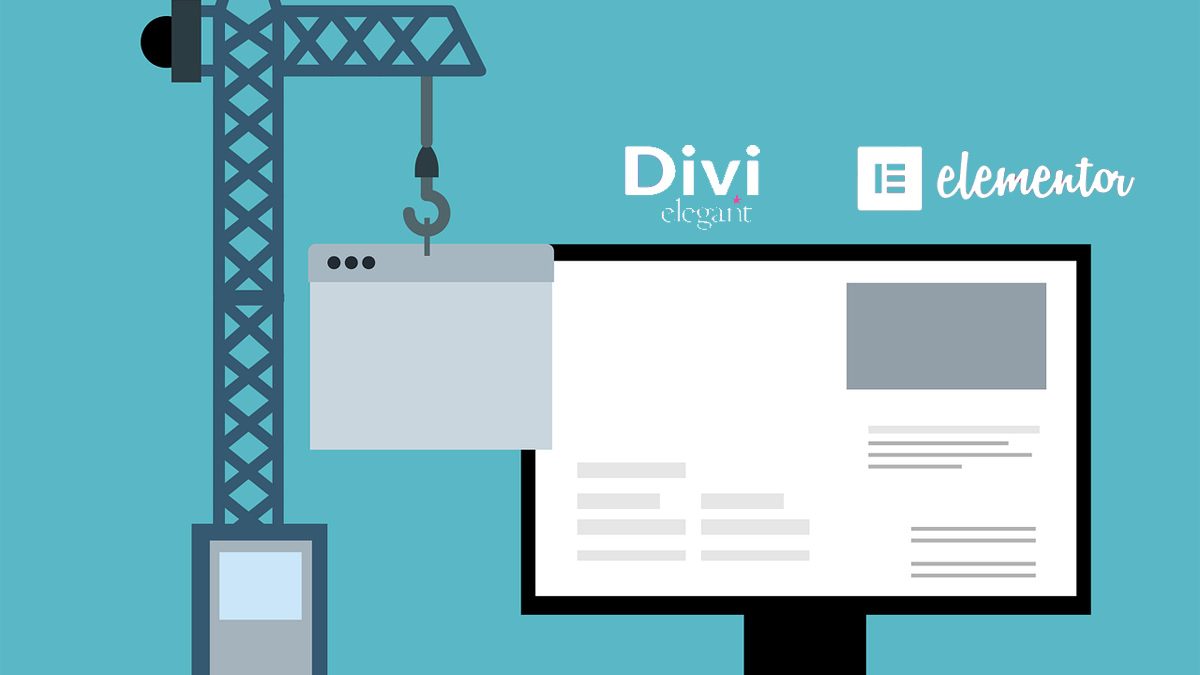Are you confused about which page builder to choose – Divi vs Elementor? Both are very popular WordPress page builders. A page builder is a website’s most crucial building block on WordPress, and it lets you create a custom website with a unique design without any coding.
Choosing a WordPress development agency enables users to create an ideal pixel-perfect website, allowing developers to extend its functionality with additional features. Divi, on the other hand, provides a broader learning curve, allowing for more customizations.
WordPress page builder comparison between Divi and Element offers a comprehensive set of personalization and functionalities for designing landing pages, blogs, portfolios, and more. Both have a visual drag-and-drop builder, various styling options, and prebuilt templates.
Understanding the essential differences between these page builders makes it easier to decide the ideal option.
Finally, deciding to choose Divi or Elementor depends upon personal preference and the specific requirements of the website. Both have strengths and features that help you create a professional website.
In this post, we will compare Divi vs. Elementor and their importance as page builders and help you choose the right one.
These two-page builders might have similar features but have been implemented in multiple ways. Due to this different implementation, it is difficult to understand and compare them just by their feature lists.
Table of Contents
ToggleOverview of Divi and Elementor
There are various WordPress alternatives; this open-source content management system attracts many users. One of the unique factors driving its popularity is WordPress plugins. These plugins enhance WordPress’s functionality and allow you to build a website just like you want.
What is Divi?
Divi is a WordPress theme created by Elegant Themes. It is designed to be a perfect solution for non-designers to build attractive websites. This is a designer’s favorite as it allows the creation of custom layouts that can suit other themes.
Divi is a combination of the theme and Visual Blender. It is referred to as Divi. This is a no-code page builder plugin with a huge variety of modules that you can drag and drop to the website. This premium page builder comes with a backend editor, making the website design process easy.
What is Elementor?
Elementor is a visual builder for WordPress that allows you to build custom layouts using drag-and-drop. It is theme-agnostic and designed to be compatible with any WordPress theme. Elementor has gained major popularity with bloggers, professional designers, and developers.
It is also a no-coding page builder that helps design beautiful websites. Certain pre-built templates are available for all pages and sections. With Elementor, you will get multiple customization options and robust add-ons.
Page Builder Features Comparison With Key Features And Functionalities –
- It contains a stock of high-quality templates for the homepage and inner page.
- Functions with powerful drag-and-drop content editor interfaces
- It can customize all website areas, including the header, footer, and theme templates.
- Various customizable elements add a range of content to your pages.
- Allows creation of reusable templates and page elements throughout the site.
- It comes with role managers to control that can access and work on the page builders on the website.
Both plugins allow you to create custom page designs from the start, but it can be time-consuming if your design is not up to the mark. You can use the required templates as they are and make a few edits to their text and images, or customize the whole set to make it unique.
This post will compare WordPress page builders to choose the best one.
User Interface and Ease of Use
A noticeable difference is the user experience with Divi vs Elementor.
- Elementor Development represents the default WordPress editor, whereas Divi has a unique UI that you will find eventually.
- For example, Divi provides a fresh layout with a blank canvas and a plus button. Clicking the button allows you to add multiple templates or start fresh with new columns and modules.
- Elementor provides a blank canvas with a fixed sidebar with widgets, styling options, and functions. You can click the Plus icon to add various columns, sections, and widgets and drag and drop them from the sidebar.
Whether you depend upon Divi or Elementor depends on your preferences and requirements.
Design and Customization Options
While considering Divi and Elementor comparisons, design is crucial in making the website attractive. Once you enter the plugin’s design mode, you can drag and drop or customize the look and layout of the entire website.
Both plugins work with a grid scheme. This scheme adds the site’s components, such as text, tables, images, and widgets, to rows and columns. This ensures that the site is responsive and maintains a good design throughout.
Divi theme vs. Elementor plugin both allow customization on every website pixel. You can change the font, colors, and background accordingly.
Layout Options
- Divi offers a full-screen experience, and you can customize the overall column layout. It allows you to add various components through contextual buttons to run in line with your website. Although rigid, it will enable you to choose predefined layouts from multiple options to suit your requirements.
- The Elementor development approach is more customizable. In the design mode, you will get a toolbox that pops up on the left side of the site and can be added by drag and drop. These are known as elements.
- Divi has 200 layout packs and 2000 premade templates for different site elements.
- For Elementor, there are 300 prebuilt templates across all categories, such as business, technology, eCommerce, blog, and more. The free version also includes 40 or more widgets, and Elementor Pro adds 50 extra widgets.
Styling Options
Regarding styling options, both the page builders are well equipped with personalisation options.
Divi allows styling in 3 levels – design, content and advanced options. These settings are available under the tabs of the same name in the module settings.
- Content Tab – This helps to edit the content of a module, like text, image, background, link, etc.
- Design Tab – It groups options like adding shadows, alignment, animation, filters and more.
- Advanced Tab allows for modifying CSS ID and classes, multiple attributes, custom CSS, etc.
For Elementor, there are three similar tabs for styling settings: content, style, and advanced.
- The content tab allows tweaking options like link, title, size, and alignment.
- Style Tab—Here, you can use editing options such as colours, opacity, borders, typography, etc.
- Advanced Tab allows you to change layout, motion effects, attributes, responsiveness, and custom CSS.
Unique Specialisations
- Divi has built-in A/B testing for modules, a useful tool for marketers. Divi’s form module provides advanced form-building capabilities with conditional logic.
- Elementor comes with its Popup Builder, which allows users to design customized popups with multiple triggers and targeting rules.
Features and Functionality
- Popup Builder:
Elementor brings various popup builders for multiple uses, whereas Divi requires an extension.
- Conditional Logic:
Divi uses built-in conditional logic within its form widget, and Elementor requires an extension to match the advanced functions.
- A/B Testing Module:
Divi uses an A/B testing module, which compares two or more web page versions to see which one functions better.
- Loop Grid and Query Builder:
Elementor works with a Loop Grid widget for customized post lists, whereas Divi requires an extra add-on for the same function.
- WireFrame View:
Divi offers WireFrame mode for block-based editing, whereas Elementor offers a less advanced Navigator.
- WordPress drag-and-drop builder comparison
Both Divi and Elementor provide a drag-and-drop visual interface, supporting inline editing. This helps to see real-time changes and presents how the visitors will see the website.
- Easy Usage
In Divi, there is a full-page editor with no fixed interface elements. Just a purple button at the bottom. In Elementor, the editing page has a fixed sidebar on the left and is more convenient to use.
Performance and Speed
Regarding the Performance comparison of Divi and Elementor, both combine CSS and JavaScript to improve the overall website performance.
- Loading Time –
Elementor’s full loading time is 2.9 seconds, a bit faster than Divi’s 2.7 seconds.
- Core Web Vitals –
Here, the Elementor performs better than Divi. The CLS for Divi is orange but green for Elementor.
The largest Contentful Paint (LCP) for Divi is 5.8 seconds and 5.4 seconds for Elementor.
- Bigger page size –
Elementor has a bigger page size but triggers fewer HTTP requests than Divi.
Speed
- Divi combines CSS and JavaScript, limiting the number of HTTP requests sent to the server.
- On the other hand, Elementor has small pages that lead to faster loading times.
Pricing and Licensing
Deciding whether to use Elementor or Divi depends upon the number of sites you need to use it on.
Elementor offers a free version, whereas Divi comes in a premium version.
Pricing Plans
Divi Page Builder is a part of the Elegant Themes premium membership. It gives access to all Elegant Themes products and website support. You can avail the membership in two plans –
- Annual Access: $89/year for one year support
- Lifetime Access: $249 (one-time payment) for lifetime support
The base plugin for the Elementor page builder is free. To use Elemetor Pro, you can choose from any of the three premium plans, which include one-year support.
- Essential Plan: $59/year for one website
- Expert Plan: $199/year for 25 websites
- Agency Plan: $399/year for 1000 websites
All things considered, Divi Builder is cheaper to use across multiple websites, which might lead you to Divi if it can do everything that you need.
Considering all the factors, Divi Builder is comparatively affordable on multiple websites.
Alternatively, if you need a page builder for a single website, Elementor Pro is a more affordable option.
User Community and Support
Both Divi and Elementor perform perfectly in terms of support and community. Both have extensive documentation and tutorials. You can get 24/7 support, offering quick solutions for any issues.
- In comparison, Divi Builder provides quicker support. Both page builders offer access to live chat support.
- All Elementor plans now include “Premium Support,” which provides access to 24/7 support through live chat or email.
Community Support
Both Divi and Elementor offer official support channels. These channels are mainly for plugin bugs and issues.
Both tools provide community support through Facebook groups –
- The official Elementor Facebook group has more than 142,000 members.
- The official Divi Facebook group has even more than 75,000 members.
- Divi comes with an extensive knowledge base. It includes documentation, tutorials and a blog.
- Elegant Themes also offers premium support with the help of chat and email for the customers.
- Elementor provides a comprehensive help centre that includes documentation, tutorials, and a blog. They even offer premium support for Pro users via email and chat.
Conclusion
Both the Divi theme and Elementor plugins are versatile WordPress page builders, and each has its strengths and weaknesses.
Divi page builder review offers an extensive library and advanced customizations. Thus making it an ideal choice for the users who prioritise design flexibility.
Elementor Review offers a structured interface and a wide range of feature sets, making it an ideal choice for those looking for a well-rounded builder with a larger community.
While choosing the Best page builder for WordPress, it is better to consider all the features and check how they can meet your unique requirements. Viewing the selection of modules is essential to check if there is any particular element that can be added to the site.
Considering all the differences between Divi and Elementor, it is observed that both offer drag-and-drop capabilities and a wide array of design options. They even cater to the different user preferences and requirements.
Although all the features are impressive, Divi stands out for its wide range of customization options. It suits those who want to extend their learning curve for a more tailored design experience.
If you want to know more about these page builders, Webskitters Ltd allows you to enhance your knowledge. Get a complete understanding of the usage of these two-page builders for the development of a website.
Atanu Sarkar, the Founder and Chief Executive Officer of Webskitters LTD & Webskitters Technology Solutions Pvt. Ltd., an award-winning Web Design & Web Development Company. He has strong data analytics, business development and entrepreneurship skills. He keeps himself updated about latest technological innovations in his past time and encourages his team to incorporate new technologies and move beyond the defined boundaries of design, development and digital marketing.
Shashi Teja
Related posts
Hot Topics
Understanding TruthFinder’s Background Check Features
Background checks have become increasingly relevant for personal safety and information gathering in digital environments. TruthFinder offers comprehensive background check…
How MLOps Is Shaping the Future of AI in Business
Artificial intelligence (AI) has evolved from a futuristic idea to a strategic necessity for companies looking to innovate, grow, and…



